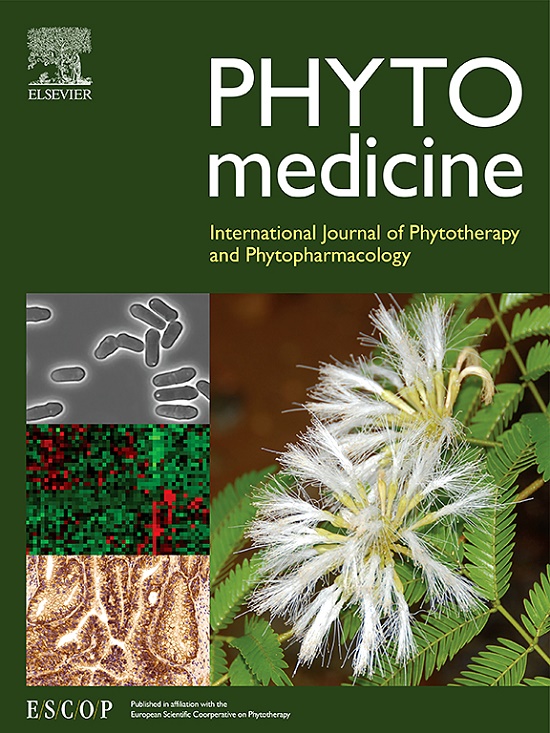Norwogonin attenuates LPS-induced acute lung injury through inhibiting Src/AKT1/NF-κB signaling pathway
IF 6.7
1区 医学
Q1 CHEMISTRY, MEDICINAL
引用次数: 0
Abstract
Background
Acute lung injury (ALI) has emerged as a critical illness, with sepsis-related ALI accounting for >80 %. In the context of bacterial infection, damage to the pulmonary microvascular barrier leads to inflammatory cell infiltration and plasma component extravasation into pulmonary interstitium. This disruption impairs gas exchange, resulting in hypoxemia. Norwogonin (NWG), a natural plant flavone, has shown potential anti-inflammatory and antioxidative effects. However, whether it could ameliorate sepsis-related ALI and the potential mechanism remains unknown.
Purpose
This study aims to investigate the effects and underlying mechanisms of NWG in treating sepsis-related ALI.
Methods
Male Wistar rats (200–220 g) were used to establish sepsis-related ALI model via intraperitoneal injection of lipopolysaccharide (LPS). Vital signs and arterial blood gas analysis, HE and immunohistochemistry staining, dynamic visualization of the microcirculatory system to observe FITC-dextran leakage and leukocyte adhesion, ELISA assay of inflammatory cytokines, Evans Blue extravasation, measurement of total protein content in bronchoalveolar lavage fluid, determination of the Wet/Dry weight ratio, Western blot and RT-qPCR analysis were used to evaluate NWG's effects and the potential mechanism. Additionally, we employed network pharmacology and molecular docking to identify and evaluate the interaction between NWG and the key targets of ALI. Surface plasmon resonance and enzyme activity assay were utilized to confirm the direct interaction between NWG and the potential targets.
Results
NWG administration improved the vital signs of LPS-stimulated rats. Exposure to LPS led to deteriorated arterial blood gas analysis, prominent lung morphology destruction, neutrophil and M1 macrophage infiltration, leukocyte adhesion, FITC-dextran leakage, elevated secretion of inflammatory cytokines, and aggravated lung edema. NWG intervention effectively mitigated these changes. Furthermore, NWG suppressed NF-κB/NLRP3 signaling and up-regulated endothelial junction proteins. Network pharmacology analysis and molecular docking identified five top key targets: MMP-9, AKT1, COX-2, Src and JAK-2. Western blot and RT-qPCR results confirmed that NWG inhibited the Src/AKT1/NF-κB signaling pathway, and down-regulated the levels of inflammatory factors. Surface plasmon resonance revealed the direct binding between NWG and AKT1, COX-2 and Src, rather than MMP-9. Enzyme activity assay demonstrated that NWG inhibited the activity of AKT1, COX-2 and Src.
Conclusion
NWG alleviated inflammation, restored pulmonary microvascular barrier function and improved LPS-induced ALI. These effects were mediated by inhibiting the Src/AKT1/NF-κB signaling pathway through direct targeting of Src, AKT1 and COX-2. Our study provided novel scientific evidence supporting the use of NWG in the treatment of ALI caused by sepsis.

求助全文
约1分钟内获得全文
求助全文
来源期刊

Phytomedicine
医学-药学
CiteScore
10.30
自引率
5.10%
发文量
670
审稿时长
91 days
期刊介绍:
Phytomedicine is a therapy-oriented journal that publishes innovative studies on the efficacy, safety, quality, and mechanisms of action of specified plant extracts, phytopharmaceuticals, and their isolated constituents. This includes clinical, pharmacological, pharmacokinetic, and toxicological studies of herbal medicinal products, preparations, and purified compounds with defined and consistent quality, ensuring reproducible pharmacological activity. Founded in 1994, Phytomedicine aims to focus and stimulate research in this field and establish internationally accepted scientific standards for pharmacological studies, proof of clinical efficacy, and safety of phytomedicines.
 求助内容:
求助内容: 应助结果提醒方式:
应助结果提醒方式:


